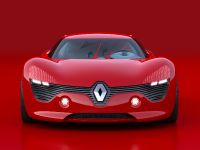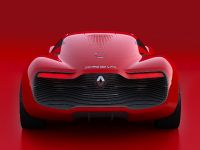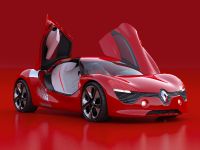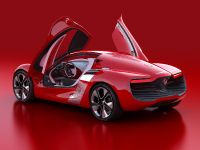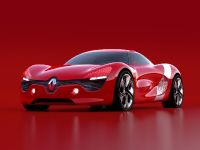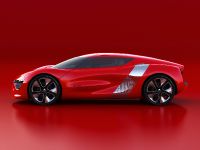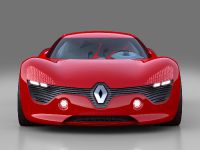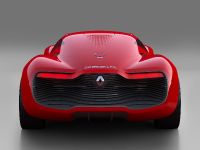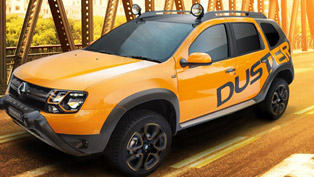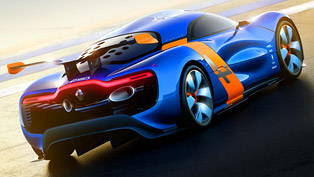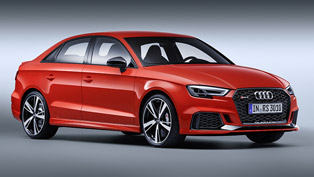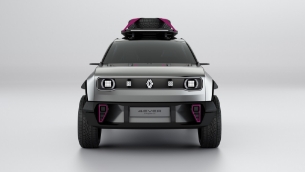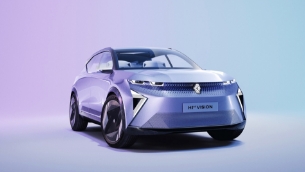Renault DeZir Concept
Renault is about to stun the world with their latest concept car – DeZir. The vehicle stands out as an illustration of the brand's commitment to more emotional styling.
It is powered by an electric motor proving that the electric vehicles and a love of cars are by no means incompatible.
The public will get its first opportunity to see DeZir at the 2010 Paris Motor Show.
The concept is created under the leadership of Laurens van den Acker, Renault's Design Department has taken its inspiration from the brand's new signature "Drive the Change" and explores Renault's styling roots to express the company's powerful human dimension via a new strategy founded on the notion of the "life cycle".
Renault DeZir Concept is the first project to be led by Laurens van den Acker and exemplifies the brand's new philosophy with regard to design. It also marks the implementation of the strategy based on the notion of a "life cycle". The first step involves falling in love, an experience that is perfectly illustrated by DeZir's powerful, sensuous styling and bright red finish; red being the colour associated with passion.
Axel Breun, Renault's Director of Concept Car and Show Car Design said: "DeZir is a statement of our new formal design language which conveys notions such as movement, sensuality and emotion through ideal proportions, in much the same way as an object whose forms have been honed by nature. The result is a warm, stimulating design that says Renault."
"My early source of inspiration stemmed from the liquid sensation, wave-like movement and contrasts in light associated with certain rippled surfaces," notes Yann Jarsalle, who was in charge of DeZir's exterior styling.
"By directly laying out volumes and not just joining together a number of surfaces by lines, I felt more in tune with the world of sculpture than with that of architecture.", he added.
The result is a two-seater coupe combining unique spirit and style.
DeZir stands on huge 21" wheels, inspirated and designed from the notion of movement.
The "Z" letter in the name of the Renault's concept stands for zero-emission. To give rhythm and balance to the overall package, this smooth, fluid skin contrasts with the ripple effect seen on the aluminium side panels, roof and headlight "eyelids".
DeZir's front end features a full-width air-intake which strikes out either side of a large, vertically-positioned Renault logo that proudly displays the car's brand pedigree. The chrome finish of the lozenge contrasts with the dark aspect of the grille to express the statement still further.
The air scoops situated at the outer extremities of the front air intake are a legacy of Renault's formal styling language and form an integral part of the air intake's design, as do the headlights which sit above these scoops.
The headlights take the form of backlit prisms, which make them a highly graphic feature. The perforated 'eyelids' add to this high-tech feel and contribute to DeZir's specific lighting signature. Rear lighting is provided by an illuminated, seemingly floating strip that extends across the full width of the car. The Renault logo is highlighted by backlighting through the fins of the grille and consequently appears to hover in the middle of this space.
Recently, it is very fashionable to have gull-wing doors and DeZir features them, too.
The concept reveals a refined interior, while the fact that the left- and right-hand doors open in opposite directions symbolises a ying and yang-style amorous harmony.
Stephane Maïore, who was in charge of DeZir's interior styling said: "Love is a sentiment that lifts you; gives you wings,".
"Inside DeZir, you feel like you're floating on a cloud," added Stephanie Petit, Colours and Materials Designer.
The predominant colour is white, although there are also echoes of the same passionate red used for the exterior. The materials used for the interior are white leather upholstery and trimming for the seats, dashboard and floor, along with a red lacquered finish for the console and accessories.
The one-piece, two-seater front benchseat provides cocoon-like comfort. Furthermore, to emphasise the sensation of shared passion and lightness, it comprises a number of interlocking elements trimmed in white leather, with a quilted pattern on the passenger's side, and a contrasting uniform finish on the driver's side, as if to suggest an inexorable attraction between the two.
The interior styling takes its inspiration from the idea of an amorous encounter and is based on a coming together of opposites:
- the cockpit-style driver's environment contrasts with the ethereal lightness of the dashboard and the feel of the white leather bench seat
- the driver's door features a bright red lacquered finish, while the panel of the passenger-side door is trimmed in white leather
- the dashboard, too, features contrasting finishes, with one part trimmed in white leather and another which exudes a more high-tech feel, with a rippled effect
- the white benchseat seems to float on a red-hued bed of light which, once again, symbolises passion. This lighting gently pulses to a rhythm that suggests a beating heart
But couples also seek to protect one another, and the forms of the interior are suggestive of this notion of protection:
- the centre console houses the transmission-mode selection lever
- the housing of the transmission-mode selection lever reveals luminous petals which indicate the selected mode
- the steering column is shrouded in a red housing that extends up to the steering wheel hub itself
DeZir is powered by an electric motor mounted in a mid-rear position to optimise weight distribution over the front and rear wheels. The vertically-mounted 24kWh lithium-ion battery is located behind the benchseat and provides the car with a range of 100 miles, which is perfect compared to the other full electric vehicles.
Batterycooling is ensured not only by the air channelled from the front to the back of the car, but also – and above all – by the flow of air that enters through the lateral scoops concealed behind the aluminium panels on either side of the body.
The basic motor is the same as the unit used for Renault's production electric cars, but the power and torque are uprated to 110kW (150ps) and 226Nm respectively.
There are three battery-charging methods:
- a standard charge using a conventional household plug (fully charges the battery in eight hours)
- a fast charge using a 400V three-phase current (charges the battery to 80 per cent of its capacity in 20 minutes)
- a fast battery exchange thanks to Renault's Quick Drop technology
In order to optimise range and dynamic performance, DeZir weight is reduced to a minimum thanks to its body is made from Kevlar, while its tubular steel frame is similar to that employed for the Megane Trophy race car.
The suspension also shares certain features with that of Megane Trophy – including a double wishbone arrangement – to deliver a particularly high standard of handling precision.
The aerodynamics are also carefully tuned. The result is a drag coefficient (Cd) of 0.25. DeZir accelerates from 0 to 62 mph in 5 seconds.
The concept features an energy efficiency package which recovers energy from the deceleration. The technology it employs is based on the same principles as the KERS (Kinetic Energy Recovery System) seen in Formula 1. When the car decelerates, kinetic energy is recovered and stored in the battery. In the case of DeZir, this energy can then be employed by the driver to provide a temporary power boost at the moment he or she chooses, using a button located on the steering wheel.
The central touchscreen display includes a smart NAV system that synchronises journey information with the driver's diary in order to optimise task management and itineraries. Software incorporated in the dashboard provides drivers with a real-time indication of their energy management ability via a fun interface that uses video-game style graphics.
Dimensions - mm
| Length | 4,225 |
| Width | 1,986 |
| Height | 1,163 |
| Height – with doors open | 2,256 |
| Width – with doors open | 2,682 |
| Ground clearance | 110 |
| Wheelbase | 2,582 |
| Front track | 1,600 |
| Rear track | 1,705 |
Technical data
| Motor | Electric synchronous motor |
| Maximum power | 110kW c/ 150hp |
| Maximum torque | 226Nm |
| Top speed | 112mph |
| 0-62mph | 5 seconds |
| Battery | Lithium-ion (24 kW/h) |
| Range | 100 miles |
| Transmission | Rear wheel drive |
| Drive | Electric with active differential |
| Chassis | Tubular steel frame |
| Tyres | 245/35 R 21 |
| Brakes | 356mm ventilated discs |
| Cd | 0.25 |
| Kerb weight | 830kg |
Partners
| Body | G Studio |
| Tyres | Michelin |
| Acoustics | IRCAM |
